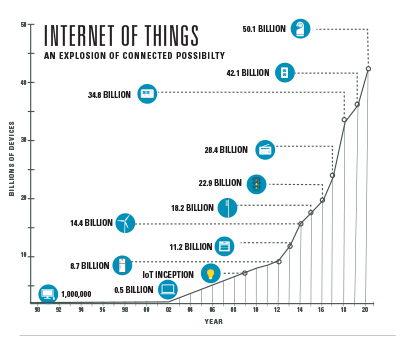IOT: Going Beyond the Buzz

The Internet of Things (IoT) has been a buzzword for a while now. It is now ready to move from hype to reality. The IoT refers to the connected network of devices, vehicles, buildings, and other items that enables the exchange, collection and analysis of data. Covering about 50 billion connected devices, the total value of IoT related business could touch $15 trillion by 2020. The price of sensors and enabling WFi connectivity in devices are plummeting to such low levels that a connected device ecosystem is no longer a distant reality.
IoT will become increasingly important in home automation and retail. In home automation, already Google Nest is enabling customers to control their thermostat, smoke detector and home security from anywhere. This control may extend to more home devices, including the refrigerator, the oven and the garage door.
In retail, the IoT helps better connect store shelves to the backroom, cut down shrinkage, enhance visibility and traceability of inventory along the supply chain and in-store, communicate to prospects through location-aware advertising, and offer customized promotions through beacons and near field communication (NFC) technologies.
In general, the IoT can significantly impact customer experience, service and care. Using information from connected devices, customer care centers can anticipate customer issues and enhance their experience and develop greater trust and loyalty with customers. In two years, about 5% of customer service cases could be initiated by connected devices and about 10% of the Fortune 500 is likely to use video service enabled by the IoT for customer care.
The IoT can help retailers lower costs, improve productivity and boost customer demand. The interesting thing about the IoT is that it is less about things and more about services and business models. For example, über is a service that leverages the IoT through smart connections; so is Clorox’s Brita that includes a WiFi enabled smart pitcher service to automatically reorder filters. Many of these “do-it-for-me” services essentially tap smartly connected devices and automated systems, creating new business opportunities.
To fully leverage the potential of the IoT, retailers need to invest more in data gathering and analysis from the IoT devices. On the demand side, retailers need to identify the best business models for services and work on their critical success drivers. Typically, such services could be subscription based services for ensuring that the connected devices keep working, fixing potential repairs, and upgrading the system. Rather than simply adding sensors and connectivity to all things and devices, the key question that companies will have to ask and answer is, “What services created by enabling and connecting devices will add value to customers and users?” If they do that, IoT-based services will fundamentally change the way we think, shop, work, play and live.
Venky Shankar is professor of marketing and Coleman chair in marketing, Director of research, Center for Retailing Studies, Mays Business School, Texas A&M University. For more information on the program visit http://mays.tamu.edu.


